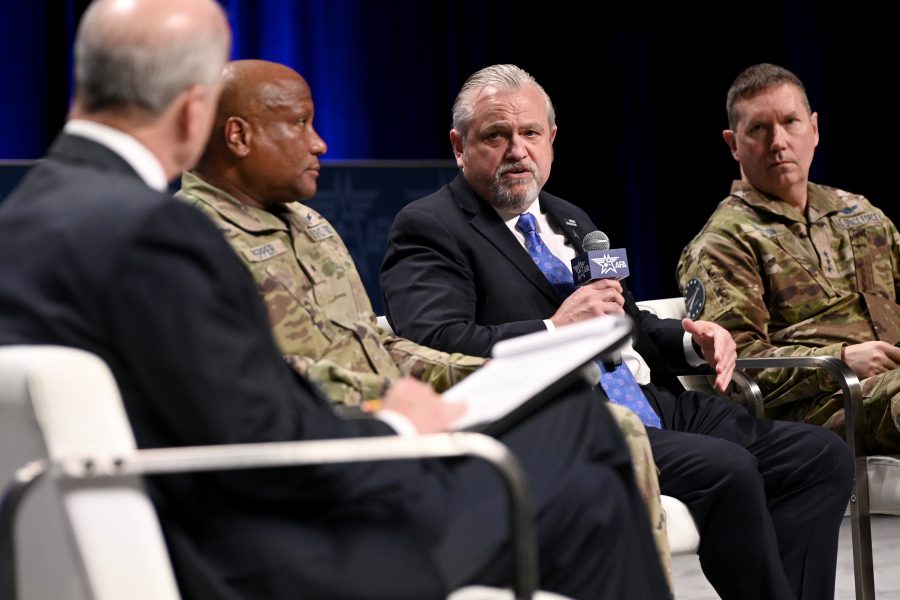
How DOD’s Overhaul of Space Classification Will Help Operations, Industry, Allies (Image Credit: airandspaceforces)
AURORA, Colo.—In January, Deputy Secretary of Defense Kathleen Hicks signed off on a new space classification policy—one that “completely rewrites” the Space Force’s approach to secret programs and could boost cooperation with commercial industry and international allies, officials say.
In a briefing with reporters, assistant secretary of Defense for space policy John Plumb said it would help provide “massive value to the warfighter.” Speaking at the AFA Warfare Symposium, Chief of Space Operation Gen. B. Chance Saltzman proclaimed the memo from Hicks to be “the most significant change in space classification policy in 20 years.
“It will help us to share more information, more quickly, with more stakeholders to better address the challenges in today’s competitive space environment,” Saltzman added.
Concerns about over-classification of military space have persisted for years now. In 2022, lawmakers urged the Pentagon to explore the possibility of declassifying additional space programs. Defense leaders, including former Air Force Secretary Barbara Barrett and former Vice Chairman of the Joint Chiefs Gen. John E. Hyten, have also backed such moves.
Within the Department of Defense and the military, classification hinders integration efforts, said Brig. Gen. Davin Pepper, vice commander of Space Operations Command
“Space has been over-classified for years,” Pepper said at the AFA Warfare Symposium. “From an operator’s perspective, the lower the classification level, the better I can integrate into a fight.”
In particular, Pepper stressed the importance of early integration of capabilities into operations, compared to waiting until the last minute. Classification, particularly the Special Access Program level that restricts access beyond top secret clearances, frustrates that.
“We have got to integrate these capabilities early on into the campaign, and certainly de-SAPing a lot of the ops capability is going to allow us to do that,” Pepper said.
Plumb highlighted the importance of such changes during his briefing as well.
“Special access programs have additional controls, which makes it very difficult to talk back and forth, even between components,” Plumb said. “And so anything we can bring from a SAP level to a top secret level, for example, massive value to the warfighter, massive value to the department.”
At the same time, Plumb indicated the goal is still to protect sensitive information.
“Inside the Beltway, people always ask me about how can I make things unclassified, and that is not actually a thing I’m all that concerned about,” Plumb said. “I’m concerned about … reducing the classification of things where they are over-classified to the point that it hampers our ability to get work done or hamper the ability of the warfighter to do their mission.”
Col. Richard A. Kniseley, senior materiel leader for the Commercial Space Office, noted that his work engaging with private industry can be significantly harder based on classification issues.
Scott Forney, president of General Atomics Electromagnetic Systems, acknowledged the importance of keeping certain operations confidential but argued that transparency and communication are key for the Pentagon’s relationship with industry, especially emerging companies.
“When you’re in the club, you get to hear the right thing, so you’re working on the right things. If you’re not in the club, it’s a very difficult place to be,” Forney said. “The downside is that you got to get the systems installed. And ever since the COVID pandemic, it’s been really, quite slow at getting the necessary communication and network systems in. It’s been quite slow to get the certifications on SCIFs or SAP facilities, and that we need some help on.”
Lt. Gen. Shawn Bratton, deputy chief of space operations for strategy, plans, programs, and requirements, agreed and said the service is starting to make that shift with the help of these new policies.
“We’re transitioning something from an idea to part of the objective force that the Space Force needs to field to compete and win,” Bratton said. “But we have got to communicate, and we have got to be really open with industry, one, to partner with them, but also to make it clear on ‘hey, these are capabilities we need and these are capabilities that still we’re not sure about.’”
With the new policy in place, Plumb said in January that the Pentagon is starting by assigning minimum classification to some things, which “will then allow services to examine their own programs and determine” whether it should be under SAP anymore. The department is also working with the U.S. Space Command to improve information sharing with global allies and partners.
“My hope is, over time, it will also allow us to share more information with allies and partners that they might not currently have—be able to share that information at the SAP level,” Plumb said. “The more things that can be shared with allies and partners, I think, the deeper that relationship could be, and that’s not going to happen overnight, but that is the path that hopefully, we have set ourselves on.”








